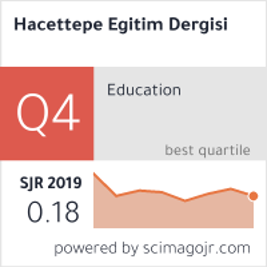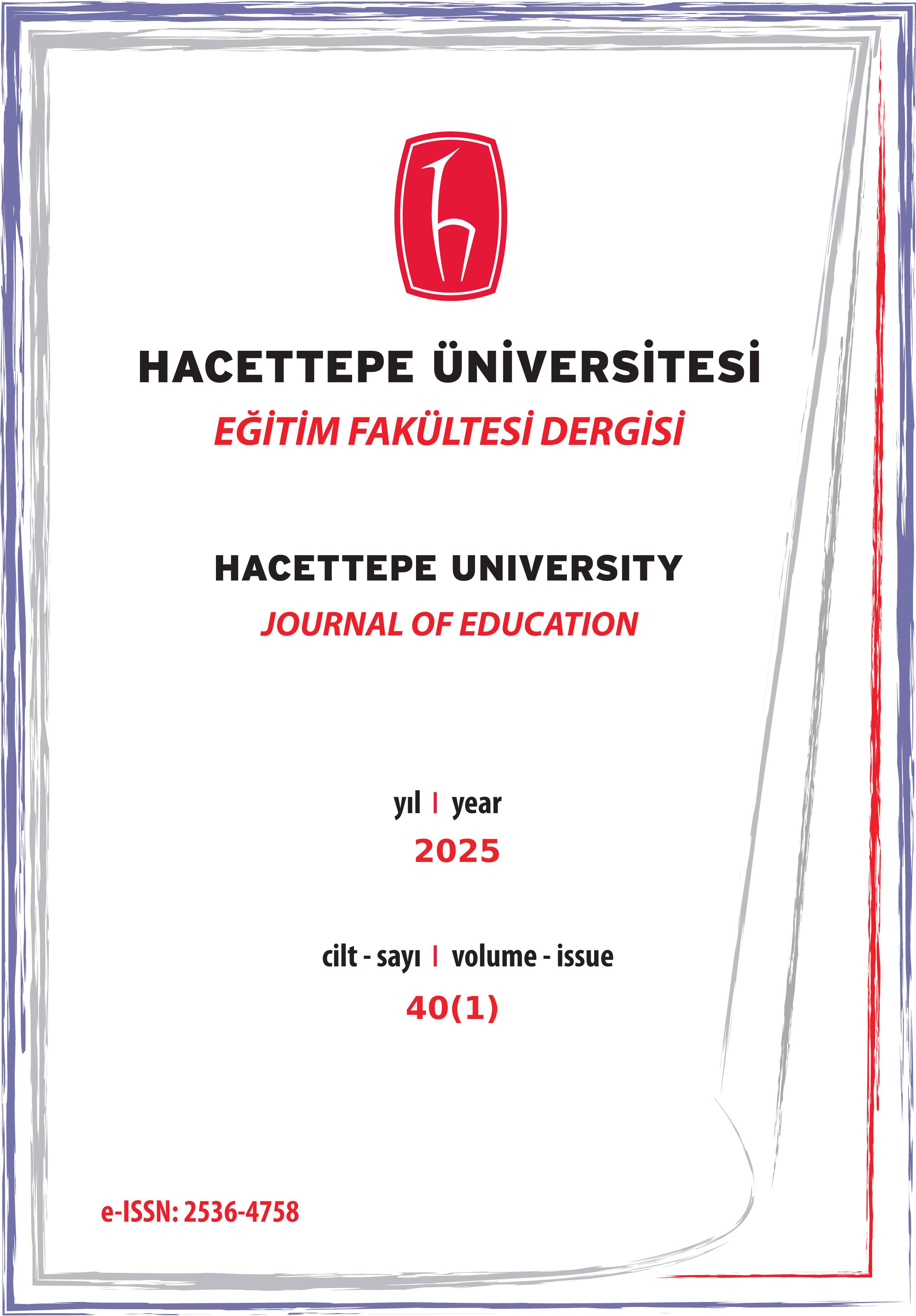Homepage
Our journal's article submission and tracking processes are carried out through the following address: https://dergipark.org.tr/pub/hunefd
 The new issue of Hacettepe University Journal of Education (2025, volume 40, 1st issue) has been published.
The new issue of Hacettepe University Journal of Education (2025, volume 40, 1st issue) has been published.
 As of February 1, 2021, only English articles will be accepted to Hacettepe University Journal of Education. Accepted Turkish articles after February 1, 2021 are required to submit a full text in English.
As of February 1, 2021, only English articles will be accepted to Hacettepe University Journal of Education. Accepted Turkish articles after February 1, 2021 are required to submit a full text in English.
 ULAKBİM updated TRDİZİN Journal Evaluation Criteria for 2020 and detailed the articles related to the ethical board approval for scientific research. In this regard, the following ethical information and documents will be requested from all articles uploaded to our journal as of the 1st of January, 2020. Without this information and the documents, even if the evaluation process of the articles is completed, they will not be accepted, they will not be published as an early view article with a doi number assigned.
ULAKBİM updated TRDİZİN Journal Evaluation Criteria for 2020 and detailed the articles related to the ethical board approval for scientific research. In this regard, the following ethical information and documents will be requested from all articles uploaded to our journal as of the 1st of January, 2020. Without this information and the documents, even if the evaluation process of the articles is completed, they will not be accepted, they will not be published as an early view article with a doi number assigned.
INFORMATION AND DOCUMENTS REQUESTED BY THE AUTHORS
-
It is obligatory to obtain the Ethics Board Approval for all articles uploaded and in the reviewing process after the 1st of January, 2020. The articles should be prepared according to the new article template.Ethics board information and statements should be specified and documented in the article.
-
The ethical statements of the authors should be included in the "Research and Publication Ethics Statement" field in the article template. There should be expressions claiming that "research and publication ethics are complied with" and / or "copyright regulations for the intellectual and artistic works used are respected" in this statement. Additionally, after the "Research and Publication Ethics Statement", the fields such as "Contribution Rates of Authors to the Article", "Support Statement", "Acknowledgment" and "Statement of Interest" should be included. Of these, "Contribution Rates of Authors to the Article" and "Statement of Interest" are mandatory to include, while "Acknowledgment" and "Support Statement" are not.
-
After the acceptance of the article, the ethical committee document should be submitted along with the author's warranty and liability document. The articles that do not present an ethics committee document and which do not include the information regarding this document will not be given a doi number and will not be possible to be published in our journal.
 NEW MANUSCRIPT TEMPLATE
NEW MANUSCRIPT TEMPLATE
The manuscript template for submissions to Hacettepe University Journal of Education has just been changed. The authors should follow the new template for their new submissions as the new template will be effective as February 1, 2021. The under review articles will be subject to change only if they are accepted for publication. The authors of the accepted articles will be contacted to modify their manuscripts in accordance with the new template and only after the completion of this procedure, their articles will be provided with DOI numbers. Therefore, there are no actions to be performed at the moment for in progress articles until the editors reach a final decision on the manuscripts. The authors of the early view articles will be contacted once their articles are assigned to an issue and they will be asked to follow the new template then. Please click here to get access to the new template.
 All articles submitted to and accepted for publication at Hacettepe University Journal of Education are published only after full clearance as result of the procedures performed in plagiarism check software and after the receipt of signed copies of “Author Responsibilities Form”. The relevant software, however, cannot identify the act of plagiarism if performed in a different language than the original text. Therefore, the authors are deemed fully responsible for the clearance of their submitted/published work.
All articles submitted to and accepted for publication at Hacettepe University Journal of Education are published only after full clearance as result of the procedures performed in plagiarism check software and after the receipt of signed copies of “Author Responsibilities Form”. The relevant software, however, cannot identify the act of plagiarism if performed in a different language than the original text. Therefore, the authors are deemed fully responsible for the clearance of their submitted/published work.


Current Issue | 40 (1), 2025
Effects of Voice, Breath Studies and Art Therapy on Academic Motivation-Anxiety of Students
Emine Ceylan ÜNAL AKBULUT, Şebnem UŞEN, Ece Merve YÜCEER NISHIDA & Emrah UÇARSixty-three of the state university, faculty of education, and department of preschool education students who experienced a lack of motivation and trait anxiety were included in an 8-week study within the scope of this study. 29 out of 63 students formed the experimental group; the remaining 34 were the control group. Students in the experimental groups formed; participated in one of the voice, breath, or art activities assigned to them online for 60 minutes per week. At the end of 8 weeks, the experimental groups were compared among themselves and with the control group; The extent to which they benefited from which study was measured with the Academic Motivation Scale developed by Vallerand et al. in 1989 and translated into Turkish by E. Yurt and E. N. Bozer in 2015, and it was investigated whether they would continue to apply what they learned in the project individually. Data were obtained from the Trait Anxiety Inventory, developed by Speilberger et al. in 1970 and translated into Turkish by Oner and Le Compte in 1985 due to validity and adaptation studies to Turkish culture. As a result of the study, the anxiety of 9 out of 10 participants in the Breath group consisting of those who received Breath training decreased. Their scores on the sub-dimensions of academic motivation remained the same. Five participants in the Voice group, consisting of those who attended voice activities, decreased their motivation. Their scores on other academic motivation sub-dimensions did not change.
Keywords: Voice activities, Breath activities, Art activities, Academic Motivation, Trait Anxiety
DOI : 10.16986/HUJE.2025.533 [HTML]
Hasan TEMEL & Hülya GÜRThis study, it is aimed to examine the mathematics curriculum of vocational education centers, secondary education, and science high schools, which are currently applied at the secondary education level, in terms of some variables according to the top-down and bottom-up approach. In the study, the document review method which is one of the qualitative research methods was used, and criterion sampling was adopted as the sampling method. The data were obtained through comparisons made by evaluating the purposes, perspective, basic philosophy, general purposes, number of acquisitions, and learning domains of the curricula. The ratios of the acquisitions in the curriculums, real-life situations, the "scientists and their studies" emphasized in the general purposes of the curriculum and information and communication technologies to all acquisitions were also examined, and it was revealed whether there was any difference between the curriculums by using descriptive statistical methods such as percentage and frequency. As a result of the research, it has been observed that there are similarities in the purposes, competencies, and general purposes of the mathematics curriculum of all three curriculums within the framework of the curriculum in which the top-down bottom-up approach is aimed. Within the framework of the applied curriculum, it was concluded that the least association was in the mathematics curriculum of vocational education centers in the examination of the associations made with scientists and their studies, real-life, and information and communication technologies in all three curriculums. In this direction, suggestions have been made for the points that need to be developed in line with the purposes, perspectives, and associations with acquisitions of the curriculums.
Keywords: Secondary education mathematics curriculum, top-down and bottom-up approach, curriculum evaluation
DOI : 10.16986/HUJE.2025.532 [HTML]
Işık Sibel KÜÇÜKÜNAL & Ayşe Dilek ÖĞRETİR ÖZÇELİKThe aim of this study was to investigate whether auditory processing difficulties are present in children with reading and writing problems and with which educational treatment programs the child's auditory functioning can be improved. A total of 30 children with an average age of 84 months, including Control 1, Control 2 and Experimental groups were included in the study. Gazi Reading and Writing Education Program (GRWEP) was prepared as an auditory processing education program to overcome reading and writing difficulty and was applied to the Experimental group for 12 weeks. Results were retrospectively compared between the groups. Experimental group showed that the reading and writing skills were significantly higher. The findings obtained were compared with auditory processing tests. Auditory processing disorder was found to affect the awareness of the speech sounds of spelling and learning to read. As a result of the study, it has been seen that the GRWEP method is effective in the educational treatment of children with reading and writing difficulties.
Keywords: Auditory processing difficulty, phonological skills, reading difficulty, writing difficulty, teaching
DOI : 10.16986/HUJE.2025.535 [HTML]
Mehmet RAMAZANOĞLU, Tayfun AKIN & Mehmet Şahin SOLAKThis study aims to determine the impact of peer mentoring in a flipped classroom environment on pre-service teachers' competence in using Web 2.0 tools and their self-efficacy in using rapid content development tools of Web 2.0. The learning environment was designed as suitable for the flipped classroom model, which can be used as an example of the hybrid approach in which online and physical environments are blended. The participants included students of the faculty of education at a public university in Turkey. In the study, in which the pre-test/post-test control group random design was used, data were collected from a total of 151 participants. Results from this study revealed a significant difference in favor of the peer mentored experimental group in terms of both the competencies in the use of Web 2.0 tools and the dimensions including Web 2.0 rapid content development self-efficacy belief.
Keywords: Peer mentoring; flipped classroom; hybrid classroom; hybrid learning; web 2.0 tools
DOI : 10.16986/HUJE.2025.536 [HTML]
Nevra ATIŞ AKYOL, Asuman BİLBAY & Mehmet KANAKThe radical changes in technology, education, and social life have resulted in changes in the personality traits, thinking styles, and skills of individuals. Teachers have a primary role in adapting children to these changing conditions. The educational opportunities offered from the early years can ensure equipping children with the knowledge and skills required by the 21st century, shaping their personality traits in this direction and having reflective thinking skills. Within this context, the importance of preschool teachers, whom the child encounters and takes as a model other than family members, comes to the fore. The present study aims to examine the mediating effect of reflective thinking tendencies on the relationship between preschool teachers’ personality traits and 21st-century skills. This research, aiming to test the mediating role of reflective thinking between preschool teachers’ personality traits and 21st-century skills, tried to reveal the relationships between variables. Therefore, path analysis from structural equation models was preferred. According to the findings of the study, reflective thinking was found to be a full mediator between “extraversion” and 21st-century skills. Reflective thinking was found to be a partial mediator between personality types “openness to development” and “self-control” and “neuroticism” and 21st-century skills. There is a positive relationship between 21st-century skills and openness to experience and self-control.
Keywords: : 21st-century skills, reflective thinking, personality
DOI : 10.16986/HUJE.2025.534 [HTML]
 The new issue of Hacettepe University Journal of Education (2025, volume 40, 1st issue) has been published.
The new issue of Hacettepe University Journal of Education (2025, volume 40, 1st issue) has been published. As of February 1, 2021, only English articles will be accepted to Hacettepe University Journal of Education. Accepted Turkish articles after February 1, 2021 are required to submit a full text in English.
As of February 1, 2021, only English articles will be accepted to Hacettepe University Journal of Education. Accepted Turkish articles after February 1, 2021 are required to submit a full text in English. ULAKBİM updated TRDİZİN Journal Evaluation Criteria for 2020 and detailed the articles related to the ethical board approval for scientific research. In this regard, the following ethical information and documents will be requested from all articles uploaded to our journal as of the 1st of January, 2020. Without this information and the documents, even if the evaluation process of the articles is completed, they will not be accepted, they will not be published as an early view article with a doi number assigned.
ULAKBİM updated TRDİZİN Journal Evaluation Criteria for 2020 and detailed the articles related to the ethical board approval for scientific research. In this regard, the following ethical information and documents will be requested from all articles uploaded to our journal as of the 1st of January, 2020. Without this information and the documents, even if the evaluation process of the articles is completed, they will not be accepted, they will not be published as an early view article with a doi number assigned. NEW MANUSCRIPT TEMPLATE
NEW MANUSCRIPT TEMPLATE All articles submitted to and accepted for publication at Hacettepe University Journal of Education are published only after full clearance as result of the procedures performed in plagiarism check software and after the receipt of signed copies of “Author Responsibilities Form”. The relevant software, however, cannot identify the act of plagiarism if performed in a different language than the original text. Therefore, the authors are deemed fully responsible for the clearance of their submitted/published work.
All articles submitted to and accepted for publication at Hacettepe University Journal of Education are published only after full clearance as result of the procedures performed in plagiarism check software and after the receipt of signed copies of “Author Responsibilities Form”. The relevant software, however, cannot identify the act of plagiarism if performed in a different language than the original text. Therefore, the authors are deemed fully responsible for the clearance of their submitted/published work. 